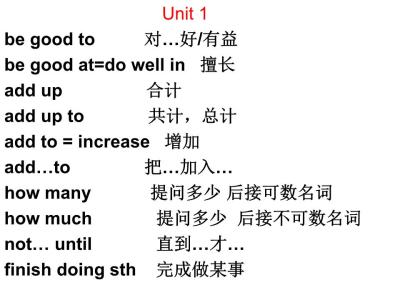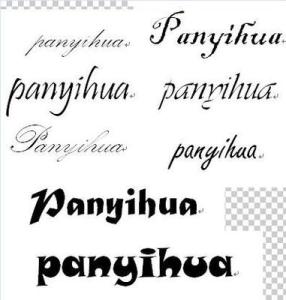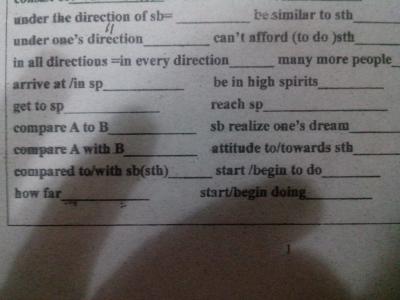艺术作品令人赏心悦目,才能达到感染人、教育人的目的。3下面是小编给大家整理的表目的的英文短语,供大家参阅!
表目的的英文短语:不定式短语可用作表示目的
不定式(短语)可用作表示目的(a),原因(b),结果(c) 等的状语: a. Sever women came over to help her.
The children sleep together to keep warm.
b. I rejoice to hear that you are well.
We jumped with joy to hear that news.
c. She lived to be 100.
The curtain parted,to reveal a market scene.
不定式还可以用在某些句型中作状语:
a. in order (not) to 以便, 为了(以免):
She went to live in Spain in order to learn Spanish.
We keep the window shut in order not to let the flies in.
b. so as (not) to 以便(以免):
Go in quietly so as to make a pie.
c. so (such) as to 到这种程度以致:
Ruth wouldn’t be so careless as to forget to lock the door. I’m not such a fool as to put it in writing.
d. be so kind (good) as to 可否劳驾.....
Would you be so kind as to let my people know?
Would you be so good as to look after her?
e. be kind (good) enough to 劳驾:
Will you be kind enough to shut the door?
Please be good enough to close the door
f. too…to… 太...不能
I’m too tired to stay up longer.
g. (not) enough to… (不)够…..来做某事
She was not strong enough to travel.
We were fortunate enough to get an empty car.
不定式有时需要用被动形式(a)或完成形式(b),有时可用进行形式(c):
a. He returned after the war, only to be told that wife had left him. b. I am sorry to have missed you.
c. Are you glad to be going back to school.
有时不定式前面有一个for引起的短语,表示它逻辑上的主语。 a.I’m quite willing for you to join us.
b.Is it ripe enough for us to eat?
有些不定式短语可用来修饰整个句子,可以称作句子状语。 To be honest , I don’t quite like the dish.
【不定式作表语】
有时不定式在句中可用作表语,说明主语的具体内容或
目的。
a. The wall is to keep people out of the garden. b. My only wish is to do what is best for you. 有时不定式表示一个动作:
a. The best thing she ever did was to buy that house. b. What you have to do is (to) fill in the questionnaire. 有时可用被动形式作表语:
The house is to be let.
He’s only to be pitied.
不定式可以用作主语:
To err is human ,to forgive divine.
一. It + be +形容词 + 不定式:
It’s important to know your own limitations.
It was silly to believe him.
二. It +be + 形容词 + for 引起的短语 +不定式: It is not hard for one to do a bit of good.
It won’t be easy for Tom to find a new job.
三. It + be +形容词 + of 引起的短语 +不定式: It’s unfair of him to criticize me.
It was selfish of him not to contribute anything.
四. It + 名词 + 不定式:
It’s fun to be here.
It has been a privilege to work with you.
五. It + 动词 (+宾语) + 不定式:
It took me a year to save up for a new coat.
It costs 150 a week to keep someone in prison.
It pleased him to think of his father.
六. It + be +介词短语汇+ 不定式:
It was quite beyond me to help them.
It is against my principles to work with them.
其它这类结构:
It makes me sick to think about it.
It would look rude to refuse their invitation.
在这类结构中,不定式有时需用进行形式或完成形式: It’s a new experience for her to be travelling by plane. What a mistake it is to have come here.
一.在不少动词可跟一个由名词(代词)+不定式构成的复合宾语:
He told her to wake him up.
My doctor advised me to see a neurologist.
二.上述动词有很多可用于被动结构,这时可说形成一种复合谓语: 这种结构有时可用完成形式或进行形式: She was told to stay at home.
He was obliged to abandon that idea.
They are believed to have discussed this problem.
He is thought to be hiding in the woods.
个别动词和一个介词短语连用,后面跟一个不定式: I pleaded with him to tell me.
You can rely on us to help you.
三. 在某些动词后可用不要to的不定式构成复合宾语: He saw them go out.
What made you think like that?
Don’t forget to have him come.
这类句子用被动结构时不定式要加to:
The man was seen to enter the building.
They were make to work long hours in the mine.
注意: 在help后面的不定式可加to,也可不加to I’ll help you (to) solve the problem.
四. 另外,不定式还可和一个疑问代词或副词一道构成复合宾语:
I advised her where to stay.
Did you ask her which to buy?
表目的的英文短语:目的状语从句
目的状语从句就是在复合句中表示主句动作发生目的的状语从句。引导目的状语从句的从属连词主要有so that(以便,为了), in order that (为了,以便) 。从句中一般含有can, could, may, might, will, would 等情态动词。此外,in case(以防,以免), lest(免得,以防), for fear that(以免,惟恐),on purpose that ,in the hope that也可以引导目的状语从句。
1. 用so that引导:so that此时的意思是“以便”。如:

She burned the letters so that her husband would never read them. 她把信都烧了,这样一来她丈夫就永远看不到了。
注意:so that引导目的状语从句与引导结果状语从句时的意思不一样。
引导目的状语从句的 so that 有时可省so 或 that,即单独用 so 或 that 来引导目的状语从句。如:
Check carefully, so any mistake will be caught. 仔细检查,以便任何错误都可检查出。
Bring it closer that I might see it better. 拿近些,使我能看得清楚些。
2. 用in order that引导:in order that的意思是“为了”。如: He studied hard in order that he could pass the exam. 他努力学习以便能考试及格。
3. 其它
Be careful lest you fall from that tree. 要当心, 以免从树上摔下来。
He hurried home for fear that he might miss his guests. 他急忙赶回家,唯恐见不到他的客人。
The teacher raised his voice on purpose that the students in the back could hear more clearly.
用in case引导:in case此时的意思是“以防”“以备”。如:
I always keep a bottle of wine by in case friends call round. 我平时总存着一瓶酒以备朋友来时喝。
It may rain—you’d better take an umbrella (just) in case it does. 可能会下雨你,最好带把伞,以防万一。
注意: in case既可引导目的状语从句,也可引导条件状语从句,主要视句意而定:
In case he comes, let me know. 如果他来,告诉我一声。 Tell me in case you get into difficulty. 遇到困难请告诉我。
【注】in case引导目的状语从句,从句有时可用“should+动词原形”这样的形式:
Take your coat in case it rains (should rain). 带着雨衣以防下雨。
目的状语从句与状语短语的转换
为了简洁起见,当目的状语从句的主语与主句的主语相同时,目的状语从句有时可用表目的的不定式短语替换:
He got up early so that he could catch the early bus. / He got up early so as to catch the early bus. 他起床很早以便赶上早班车。
He came in quietly in order that he shouldn't wake his wife. / He came in quietly in order not to wake his wife. 他轻轻进来,以免把他妻子吵醒。
有时还可与表示目的的介词短语替换
He left an hour early for fear he might miss the train. / He left an hour early for fear of missing the train. 他提前一小时离开,以免错过火车。
 爱华网
爱华网



